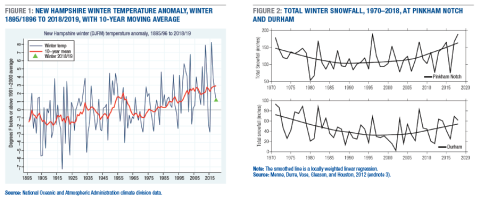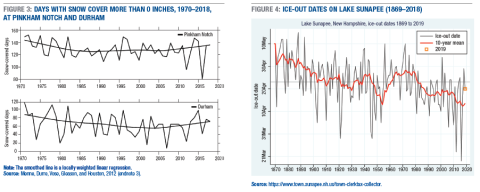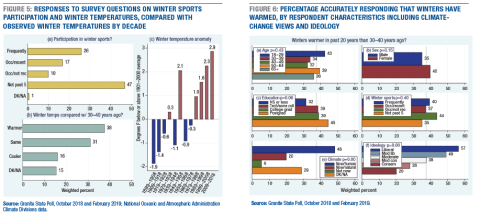download the brief
Key Findings



Awareness of winter warming corresponds most closely to respondents’ political identity: liberals and moderates are more likely than conservatives to be aware of or acknowledge the warming trend.
Introduction
Since 1895, New Hampshire’s average winter temperatures (December through March) have warmed by more than 4 degrees Fahrenheit, with broad impacts on many aspects of daily life, from snow shoveling and gardening to participating in—and running businesses sustained by—winter sports. The warming trend follows rising greenhouse gases: since the 1970s, nearly 80 percent of winters have been above the long-term average, and the top-five warmest winters have all occurred since 1998.
This brief reviews some basic evidence about winter warming in New Hampshire, explores to what extent state residents are aware of this trend, and asks who is aware, in terms of characteristics such as age, education, or participation in winter sports. Results from two statewide surveys find limited awareness of the trend overall, and no significant differences by age, education, or winter sports participation. Instead, perceptions of this winter trend depend on political identity: conservatives are much less likely than other groups to recognize that warming has occurred.
Signs of Winter Warming
Figure 1 plots New Hampshire average winter temperature anomalies (deviations from the 1901–2000 mean) for 1895/1896 to 2018/2019. The two warmest winters of the past decade set new records, and the coldest of recent winters were still warmer than many in the first half of the 20th century. Winter temperatures swing widely from one year to the next, but the longer-term trend—marked here by a 10-year moving average—has drifted upward by more than 4 degrees (all temperatures in this brief are Fahrenheit). We might think of the blue line in Figure 1 as “weather,” and the red line as “climate” (average weather), which is changing.
Figure 2 illustrates how this variability can play out, using data from two of the “most different” New Hampshire weather stations: Pinkham Notch, high in the White Mountains; and Durham, in the state’s balmier seacoast region. At Pinkham Notch (top panel), total winter snowfall from 1970 to 2018 tended to be lower from the mid-1980s through the early 2000s than in the years before or after. A similar pattern occurred in Durham (bottom panel). As long as winter temperatures remain just below freezing, New Hampshire can expect to experience heavy snowfall. Warming temperatures across the state do not necessarily translate to less snowfall over time; indeed, they may even translate to more. With each 1°F rise in temperature, the atmosphere can hold 4 percent more moisture. The heaviest snowfalls generally occur near an atmospheric “sweet spot” between 28 and 32 degrees.

Keeping the snow on the ground, however, requires that below-freezing temperatures persist longer than a single storm event. Since 1970, the number of days with snow cover (snow depth greater than 0 inches) has decreased by about one week in Pinkham Notch and by over two weeks in Durham (Figure 3). The trend toward fewer days with snow cover is consistent with longer-term records across the broader Northeast region, which has experienced a statistically significant 12- to 45-day decrease in snow-covered days over the period 1917–2016.
For winter sports participants who spend time on frozen lakes, the date when ice melts in the spring (“ice-out date”) can be a noticeable symptom of warming. At Lake Sunapee, records going back to 1869 show a dramatic change: ice-out now averages several weeks earlier than it did in the past. The two earliest ice-outs, by far, occurred in the past few years: 2012 and 2016 (Figure 4).

Who Notices Winter Warming?
Are older residents or winter sports participants more likely than other people to have noticed the warming trend? What else might make a difference? To explore such questions, we turned to the University of New Hampshire Survey Center’s Granite State Poll (GSP), which conducts telephone interviews with random samples of about 500 state residents four times a year. The high-quality GSP data have been widely used for political opinion studies, as well as for basic research. In October 2018 and February 2019, the GSP included two new questions asking state residents about their participation in winter sports and their perceptions of recent winter warming. The questions’ wording, with weighted response percentages based on 1,211 interviews, are as follows:
Over the past five years, how often have you participated in outdoor winter activities such as skiing, snowboarding, snowshoeing, ice fishing, or snowmobiling?
- Frequently, many times each winter (26%)
- Occasionally, including the most recent winter (17%)
- Occasionally, but not in the most recent winter (10%)
- Not in past five years (47%)
- Don’t know/no answer (1%)
Which of the following statements do you think is more accurate? New Hampshire winter temperatures over the past 20 years …
- Have been warmer, on average, than winters 30 or 40 years ago (38%)
- Have been about the same, on average, as winters 30 or 40 years ago (31%)
- Have been cooler, on average, than winters 30 or 40 years ago (16%)
- Don’t know/no answer (15%)
The first two panels (a and b) of Figure 5 illustrate responses to the sports and warming questions, respectively. Panel c charts actual temperatures by decade. To make these temperatures comparable to our question wording on our 2018/2019 survey, we grouped them with the most recent decade as 2009–2018 (winters of 2008/2009 to 2017/2018). The two recent decades were the warmest on record.
On the temperatures question, only 38 percent of the statewide sample recognized that winters have warmed over the past 20 years, 31 percent thought they had been about the same, and 16 percent incorrectly guessed cooler.
Figure 6 charts the percentage of accurate responses among different subsets of survey respondents. (Probabilities or p values less than 0.05 indicate statistically significant differences.) The first four panels show that winter-warming awareness does not differ significantly across age groups, between men and women, by education, or by winter sports participation. Instead, its main patterns are political. Fifty-seven percent of liberals but only 20 percent of conservatives acknowledge the recent warming trend. Similarly, 48 percent of those who agree that climate change is happening now and caused mainly by human activities, compared with just 20 percent of those who think climate change is happening but caused mainly by natural forces, acknowledge the warming trend.

Equally strong patterns, not shown, occur with other political indicators as well. For example, there is a 31-point gap between Democrats and Tea Party supporters, and a 26-point gap between those who approve and disapprove of President Trump, in awareness of winter warming.
These New Hampshire results parallel findings from a 2017 study that focused on the snowier North Country of northern New Hampshire, Vermont, and Maine, where winter warming has been noticed by majorities of all age groups, by men and women, and by residents regardless of education level—but not by the most conservative. Equally strong political patterns appeared in a survey of eastern Oregon residents, where summer warming has been accompanied by rising wildfire risks.
Discussion
High-quality temperature records in New Hampshire clearly indicate a robust and significant winter warming trend over the last 40 years, yet fewer than half of the respondents on a statewide survey were aware of this warming. It is possible, of course, that subjective impressions of winter warming (or the lack thereof) might be more responsive to the visual cues provided by snowfall and snow cover, instead of to the more subtle change in temperature. In other words, the lack of consistent or statistically robust trends in winter snowfall and snow cover over the past 20 years may cause some residents to believe there has been little change in temperature.
Respondents may also be subject to “shifting baseline syndrome,” or the sociological and psychological phenomenon wherein individuals shift their expectation of normal environmental conditions, decoupled from rapidly changing conditions. For example, a recent study that tracked remarkability of weather phenomena using social media found that the reference point for “normal” conditions is largely anchored on weather experienced within the most recent two to eight years—a period considerably shorter than the climatology community’s definition of a 30-year climate normal. A more rapid shift in the perceived baseline expectation of weather shifts than in actual climatological trends could help explain why fewer than half of survey respondents could correctly identify the recent warming. Winter sports participants and nonparticipants may be equally subject to shifting baseline syndrome.
Future studies might consider how type of winter sport influences perceptions of warming winters. For example, downhill skiers are well adapted for a warmer climate because of extensive snowmaking that provides skiable terrain even in warmer-than-average winters. About 70 percent of total skiable acreage in the Northeastern United States can rely on artificial snowmaking to maintain coverage when natural snow is not sufficient. Other winter sports such as snowmobiling, cross-country skiing, ice fishing or pond skating lack similar options. For snowmobilers, snowmaking on extensive trail networks is extremely uncommon. Ice fishing relies exclusively on mother nature to provide safe ice conditions, although pond hockey enthusiasts can settle for indoor rinks.
Within the downhill ski community, studies investigating skiers’ perceptions of winter warming and climate change in the United States appear to be limited and are focused primarily on adaptive responses, not perceptions of recent warming or climate change beliefs. Focus groups, surveys, and questionnaires targeting ski resort owners, operators, and stakeholders in Europe suggest that climate change is generally accepted as happening, though the level of threat to tourism business models remains unsettled.
Endnotes
1. L.C. Hamilton, M. Lemcke-Stampone, and C. Grimm, “Cold Winters Warming? Perceptions of Climate Change in the North Country,” Weather, Climate, and Society 10 (October 2018): 641–52, doi: 10.1175/WCAS-D-18-0020.1.
2. K. Trenberth, “Does Global Warming Mean More or Less Snow?” The Conversation, January 30, 2015, http://theconversation.com/does-global-warming-mean-more-or-less-snow-3….
3. M.J. Menne, I. Durre, R.S. Vose, B.E. Gleason, and T.G. Houston, “An Overview of the Global Historical Climatology Network-Daily Database,” Journal of Atmospheric and Oceanic Technology 29 (2012): 897-910, doi.10.1175/JTECH-D-11-00103.1.
4. L.C. Hamilton, J. Hartter, and E. Bell, “Generation Gaps in U.S. Public Opinion on Renewable Energy and Climate Change,” PLoS One (2019), doi: 10.1371/journal.pone.0217608.
5. Hamilton, Lemcke-Stampone, and Grimm, 2018.
6. L.C. Hamilton, J. Hartter, B.D. Keim, A.E. Boag, M.W. Palace, F.R. Stevens, and M.J. Ducey, “Wildfire, Climate, and Perceptions in Northeast Oregon,” Regional Environmental Change 16 (2016): 1819–32, doi: 10.1007/s10113-015-0914-y.
7. D. Pauly, “Anecdotes and Shifting Baseline Syndrome of Fisheries,” Trends in Ecology and Evolution 10, no. 10 (1995): 430; M. Soga and K.J. Gaston, “Shifting Baseline Syndrome: Causes, Consequences, and Implications,” Frontiers in Ecology and the Environment 16, no. 4 (2018), https://doi.org/10.1002/fee.1794.
8. F.C. Moore, N. Obradovich, F. Lehner, and P. Baylis, “Rapidly Declining Remarkability of Temperature Anomalies May Obscure Public Perception of Climate Change,” Proceedings of the National Academy of Sciences 116, no. 11 (2019): 4905–10.
9. National Ski Areas Association (NSAA), “Kottke National End of Season Survey 2016/2017: Final Report” (NSAA, RRC Associates, 2017).
10. R. Steiger, D. Scott, B. Abegg, M. Pons, and C. Aall, “A Critical Review of Climate Change Risk for Ski Tourism,” Current Issues in Tourism 22, no. 11 (2019): 1343–79, https://doi.org/10.1080/13683500.2017.1410110.
11. L. Trawöger, “Convinced, Ambivalent or Annoyed: Tyrolean Ski Tourism Stakeholders and Their Perceptions of Climate Change,” Tourism Management 40 (2014): 338–51, http://dx.doi.org/10.1016/j.tourman.2013.07.010.
About the Authors
Dr. Elizabeth Burakowski is a Research Assistant Professor in the Institute for the Study of Earth, Oceans, and Space at the University of New Hampshire. Her research focuses on past and future changes in winter climate in the northeastern United States.
Lawrence C. Hamilton is professor of sociology and a senior fellow at the Carsey School of Public Policy at the University of New Hampshire.
Acknowledgments
Support for this work came from the National Science Foundation Established Program to Stimulate Competitive Research (EPSCoR, NSF #1832959).
